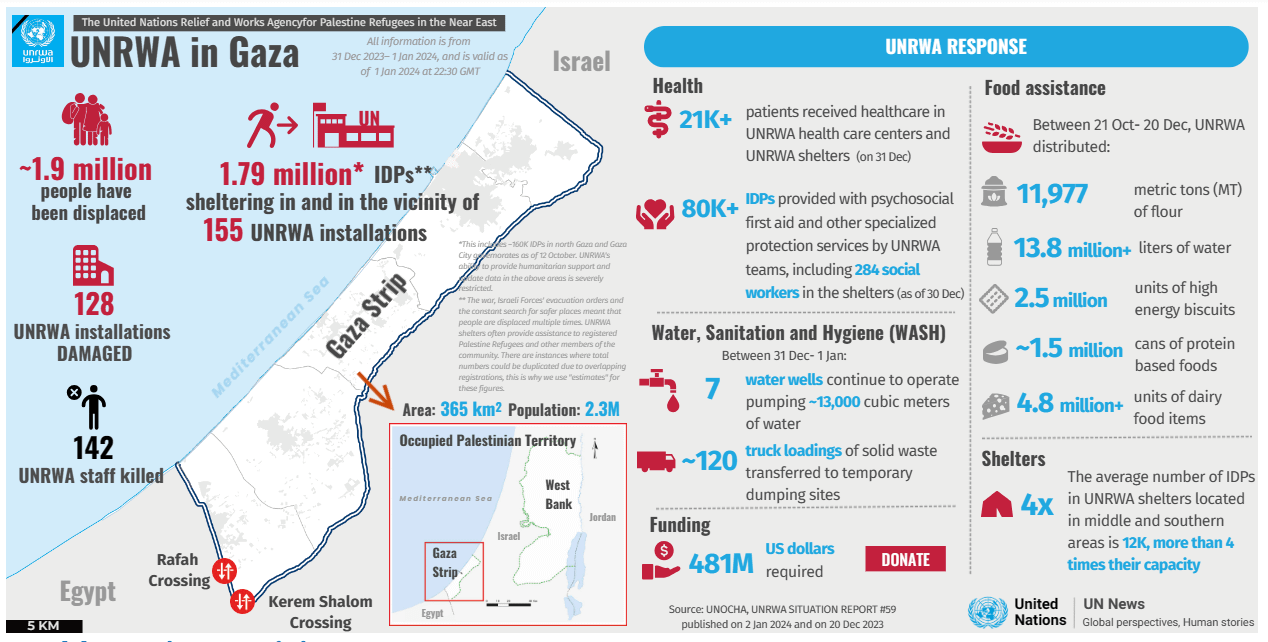UN humanitarians repeated dire concerns for civilians caught up in the war in Gaza on Tuesday, amid reports of continued Israeli bombardment of the southern towns of Deir al Balah, Khan Younis and Rafah, direct clashes on the ground and the firing of rockets overnight by Palestinian armed groups into Israel.
The latest warnings from UN relief agency for Palestinians UNRWA and the UN World Food Programme, WFP, highlighted the threat of starvation and disease in heavily built-up areas, where tens of thousands of people have fled intense bombing campaigns in the enclave’s north and centre.
Skipping meals
🔺212 incidents – including 60 direct hits – impacting @UNRWA premises & the people inside them have been reported in #Gaza since the war began.
🔺At least 315 people sheltering in @UNRWA shelters have been killed & at least another 1,148 were injured.https://t.co/TgvhhChmxR pic.twitter.com/iG54MEyFJa
— UNRWA (@UNRWA) January 2, 2024
“Everyone in Gaza is hungry! Skipping meals is the norm, and each day is a desperate search for sustenance,” WFP said in a post on X (formerly Twitter) on Tuesday. “People often go the entire day and night without eating. Adults go hungry so children can eat.”
Well over a million people are now seeking safety in the already overcrowded southern city of Rafah, according to UNRWA, with hundreds of thousands sleeping in the open with inadequate clothing or materials to keep out the cold.
Undernourished children are at particular risk, while “half of Gaza’s population is starving” UN humanitarians have warned, in line with the latest food insecurity assessments.
Infections spreading
Echoing those concerns, the UN health agency WHO warned of an “imminent risk” of communicable disease outbreaks.
Since mid-October, there have been 179,000 cases of acute respiratory infection, 136,400 cases of diarrhoea among under fives, 55,400 cases of scabies and lice and 4,600 cases of jaundice, it reported.
UNRWA said in a new update late on Tuesday that at least 315 people have been killed while seeking safety in their shelters since the latest cycle of conflict began, with at least another 1,148 injured. There have also been around 212 incidents, including 60 direct hits, which have impacted agency premises overall.
The latest figure for UNRWA staff killed now stands at 142. Since 7 October, up to 1.9 million Gazans – that’s 85 per cent of the population – have been displaced, some multiple times.
Death toll climbs over 22,000
Since the Hamas-led terror attacks in southern Israel on 7 October that left some 1,200 dead and another 240 taken hostage, clashes in the Gaza Strip and strikes from the air, land, and sea by the Israeli Defense Forces (IDF) have claimed the lives of more than 22,000 people, mainly women and children, according to local health officials.
IDF figures from 30 December indicated that 168 Israeli soldiers have been killed since the start of the ground operation in Gaza and 955 injured.
Gaza’s health ministry also reportedly stated that more than 200 Palestinians have been killed since Monday alone, with 338 wounded.

Thousands more presumed dead
An additional 7,000 people have also been reported missing or buried under rubble, the UN health agency WHO said in its latest emergency update.
The report also noted that 600 people have been killed in nearly 300 attacks on healthcare since 7 October that have damaged 26 hospitals and 38 ambulances.
Of the 1.93 million displaced in Gaza, some 52,000 pregnant women are giving birth to around 180 babies every day, according to the WHO update. It also detailed that 1,100 patients need kidney dialysis, 71,000 have diabetes and 225,000 need treatment for high blood pressure.

Health services reviving
UN aid coordination agency OCHA also noted that the Gazan health authorities had managed to resume some hospital services in the north of Gaza.
These included Al Ahli Arab Hospital, the Patients Friends charity hospital, Al Helou International hospital, Al Awda hospital and a number of other primary care centres.
“This occurred amidst great risks surrounding the movement and work of medical teams due to the continuous bombing of residential neighborhoods and the vicinity of health facilities,” OCHA said.
“Furthermore, the Ministry of Health in Gaza, UNRWA and WHO are coordinating on a plan for the reactivation of health centres to meet the needs of displaced people in all places of displacement.”
West Bank crisis

In a related development, OCHA reported the first case of the demolition of Palestinian property in the West Bank in 2024, in al-Maniya in Bethlehem.
Some 300 Palestinians – including 79 children – have been killed across the occupied West Bank since 7 October, amid increasing attacks by Israeli Security Forces and settlers that have been confirmed and condemned by UN human rights chief Volker Türk.
Before the Hamas-led 7 October attacks, 200 Palestinians had already been killed in the West Bank last year – the highest number in a 10-month-period since the UN began keeping records in 2005.
According to a report by the UN human rights office OHCHR encompassing 7 October to 20 November, the period saw a “sharp increase in airstrikes as well as in incursions by armoured personnel carriers and bulldozers sent to refugee camps and other densely populated areas in the West Bank, resulting in deaths, injuries and extensive damage to civilian objects and infrastructure”.
Last year, Israeli authorities oversaw the demolition of 1,119 structures – a record since data collection began in 2009 – uprooting 2,210 people, according to OCHA, in its first update of 2024.
“The threat of destruction of homes and sources of livelihood contributes to the generation of a coercive environment pressuring people to leave their areas of residence,” the aid wing said on its website.
Source: UPDATED: Everyone is hungry in Gaza, warn UN humanitarians | UN News
